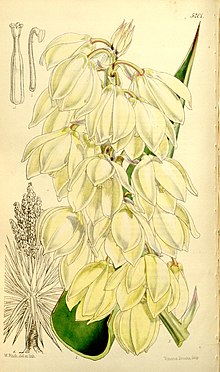Yucca treculiana
Appearance
| Yucca treculiana | |
|---|---|

| |
| 1860 illustration[1] | |
| Scientific classification | |
| Kingdom: | Plantae |
| Clade: | Tracheophytes |
| Clade: | Angiosperms |
| Clade: | Monocots |
| Order: | Asparagales |
| Family: | Asparagaceae |
| Subfamily: | Agavoideae |
| Genus: | Yucca |
| Species: | Y. treculeana
|
| Binomial name | |
| Yucca treculeana Carrière
| |
| Synonyms[2] | |
| |
Yucca treculeana Carrière[3] is a plant in the family Asparagaceae, native to Texas, New Mexico and Coahuila.[4] Common names include Spanish dagger, Spanish bayonet and Don Quixote's lace.
Yucca treculeana is a large, tree-like species up to 10 m (33 feet) tall, often branching above the ground. Leaves are up to 128 cm (50 inches) long. Flowers are cream-colored, sometimes tinged with purple. Fruits are fleshy and succulent, up to 19 cm (7.5 inches) long. [5][6]
Some sources list this species as "Yucca spinosa Kunth." However, the type specimen for this name at the herbarium in Berlin appears to be Dasylirion sp., thus rendering the name a "nomen confusum."[7]
References
- ^ Yucca treculeana (as Yucca canaliculata) Bot. Mag. 86. t. 5201. 1860.
- ^ Tropicos Yucca treculeana
- ^ Carrière, Rev. Hort. IV, 7: 580 1858.
- ^ Encyclopedia of Life map
- ^ http://www.efloras.org/florataxon.aspx?flora_id=1&taxon_id=242102078
- ^ McKelvey, S. D. 1938–1947. Yuccas of the Southwestern United States. 2 vols. Jamaica Plain.
- ^ Digital specimen images at the Herbarium Berolinense
